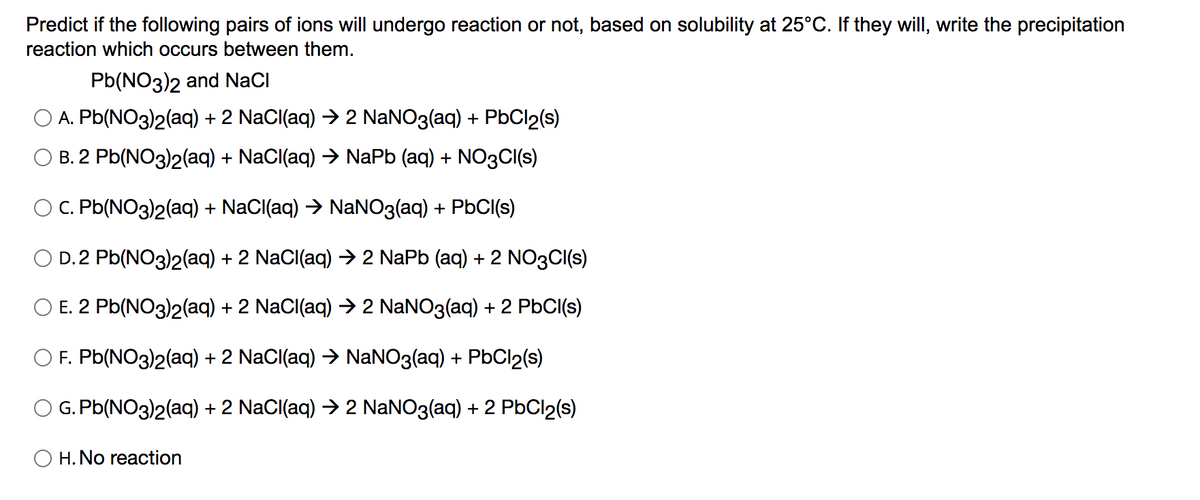Predict if the following pairs of ions will undergo reaction or not, based on solubility at 25°C. If they will, write the precipitation reaction which occurs between them. Pb(NO3)2 and NaCI O A. Pb(NO3)2(aq) + 2 NaCl(aq) → 2 NANO3(aq) + PbCl2(s) O B. 2 Pb(NO3)2(aq) + NaCl(aq) → NaPb (aq) + NO3CI(s) O C. Pb(NO3)2(ag) + NaCl(aq) → NaNO3(aq) + PbCl(s) O D.2 Pb(NO3)2(aq) + 2 NaCI(aq) → 2 NaPb (aq) + 2 NO3CI(s) O E. 2 Pb(NO3)2(aq) + 2 NaCl(aq) → 2 NaNO3(aq) + 2 PbCl(s) O F. Pb(NO3)2(aq) + 2 NaCl(aq) → NaNO3(aq) + PBCI2(s) O G. Pb(NO3)2(aq) + 2 NaCl(aq) → 2 NANO3(aq) + 2 PbCl2(s) O H. No reaction
Predict if the following pairs of ions will undergo reaction or not, based on solubility at 25°C. If they will, write the precipitation reaction which occurs between them. Pb(NO3)2 and NaCI O A. Pb(NO3)2(aq) + 2 NaCl(aq) → 2 NANO3(aq) + PbCl2(s) O B. 2 Pb(NO3)2(aq) + NaCl(aq) → NaPb (aq) + NO3CI(s) O C. Pb(NO3)2(ag) + NaCl(aq) → NaNO3(aq) + PbCl(s) O D.2 Pb(NO3)2(aq) + 2 NaCI(aq) → 2 NaPb (aq) + 2 NO3CI(s) O E. 2 Pb(NO3)2(aq) + 2 NaCl(aq) → 2 NaNO3(aq) + 2 PbCl(s) O F. Pb(NO3)2(aq) + 2 NaCl(aq) → NaNO3(aq) + PBCI2(s) O G. Pb(NO3)2(aq) + 2 NaCl(aq) → 2 NANO3(aq) + 2 PbCl2(s) O H. No reaction
Chemistry: Principles and Reactions
8th Edition
ISBN:9781305079373
Author:William L. Masterton, Cecile N. Hurley
Publisher:William L. Masterton, Cecile N. Hurley
Chapter15: Complex Ion And Precipitation Equilibria
Section: Chapter Questions
Problem 76QAP
Related questions
Question
3

Transcribed Image Text:Predict if the following pairs of ions will undergo reaction or not, based on solubility at 25°C. If they will, write the precipitation
reaction which occurs between them.
Pb(NO3)2 and NaCI
A. Pb(NO3)2(aq) + 2 NaCl(aq) → 2 NaNO3(aq) + PbCl2(s)
B. 2 Pb(NO3)2(aq) + NaCl(aq) → NaPb (aq) + NO3CI(s)
C. Pb(NO3)2(aq) + NaCl(aq) → NaNO3(aq) + PbCl(s)
D.2 Pb(NO3)2(aq) + 2 NaCl(aq) → 2 NaPb (aq) + 2 NO3CI(s)
O E. 2 Pb(NO3)2(aq) + 2 NaCl(aq) → 2 NaNO3(aq) + 2 PbCl(s)
F. Pb(NO3)2(aq) + 2 NaCl(aq) → NaNO3(aq) + PbCl2(s)
G. Pb(NO3)2(aq) + 2 NaCl(aq) → 2 NaNO3(aq) + 2 PbCl2(s)
O H. No reaction
Expert Solution
This question has been solved!
Explore an expertly crafted, step-by-step solution for a thorough understanding of key concepts.
This is a popular solution!
Trending now
This is a popular solution!
Step by step
Solved in 2 steps

Knowledge Booster
Learn more about
Need a deep-dive on the concept behind this application? Look no further. Learn more about this topic, chemistry and related others by exploring similar questions and additional content below.Recommended textbooks for you

Chemistry: Principles and Reactions
Chemistry
ISBN:
9781305079373
Author:
William L. Masterton, Cecile N. Hurley
Publisher:
Cengage Learning

Chemistry & Chemical Reactivity
Chemistry
ISBN:
9781337399074
Author:
John C. Kotz, Paul M. Treichel, John Townsend, David Treichel
Publisher:
Cengage Learning

Chemistry: The Molecular Science
Chemistry
ISBN:
9781285199047
Author:
John W. Moore, Conrad L. Stanitski
Publisher:
Cengage Learning

Chemistry: Principles and Reactions
Chemistry
ISBN:
9781305079373
Author:
William L. Masterton, Cecile N. Hurley
Publisher:
Cengage Learning

Chemistry & Chemical Reactivity
Chemistry
ISBN:
9781337399074
Author:
John C. Kotz, Paul M. Treichel, John Townsend, David Treichel
Publisher:
Cengage Learning

Chemistry: The Molecular Science
Chemistry
ISBN:
9781285199047
Author:
John W. Moore, Conrad L. Stanitski
Publisher:
Cengage Learning